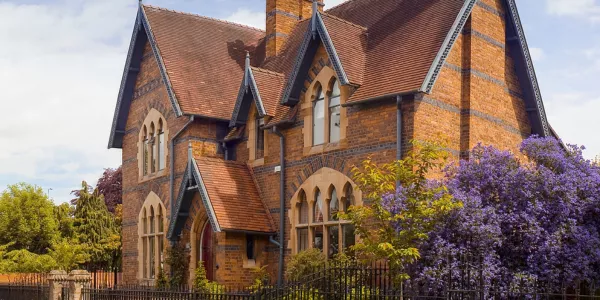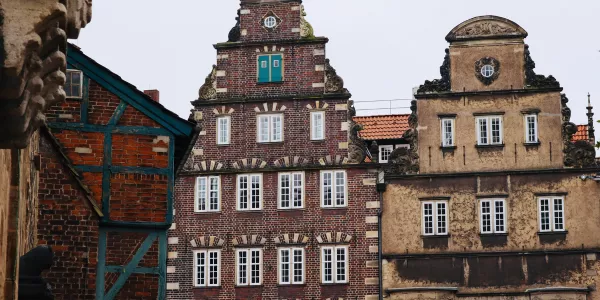Germany, a country rich in history and culture, boasts a diverse range of architectural styles in its residential buildings. From the enchanting half-timbered houses of the medieval era to the Bauhaus-inspired modernist structures, German homes are as varied as the country's landscapes.
Here, we will discuss the quintessential German home, exploring traditional styles, the differences between German and American homes, and the advantages and disadvantages of living in a German dwelling.
What Is the Typical German Home Like?
The architectural landscape of German homes is remarkably diverse, heavily influenced by the region's history, geography, and cultural influences. This diversity ensures that the "typical" German home can vary significantly from one area to another.
Rural Charms: Half-Timbered Houses
- Design: In many rural parts of Germany, especially in regions such as Bavaria, the Black Forest, and parts of Lower Saxony, the traditional half-timbered houses ('Fachwerkhäuser') are iconic. These homes are characterized by their distinctive timber frames, with the spaces between the timbers filled with plaster, brick, or stone.
- Features: These houses are easily recognized by their steeply pitched roofs, designed to handle heavy snowfall, and smaller windows, which were historically practical for insulation. The interiors of these homes are often described as cozy and warm, with exposed wooden beams and intricate carpentry adding to their charm.
- Cultural Significance: Beyond their aesthetic appeal, half-timbered houses hold historical significance, representing a construction method that dates back to the Middle Ages. Many of these homes have been meticulously preserved, showcasing the craftsmanship and architectural traditions of their time.
Urban Diversity: A Blend of Old and New
- Historic Buildings: Germany's urban areas are a tapestry of architectural styles, reflecting the country's rich history. In cities like Berlin, Cologne, and Munich, it's not uncommon to find historic buildings that have stood the test of time, some even dating back to medieval times.
- Modern Apartments: Alongside these historic gems, Germany's cities are also home to modern apartments and residential buildings. These structures embody contemporary design principles, prioritizing functionality, energy efficiency, and sleek aesthetics. The use of glass, steel, and concrete is prevalent, with clean lines and minimalist designs dominating the urban residential landscape.
- Sustainable Living: In recent years, there has been a significant shift towards sustainable and eco-friendly living in urban German homes. New constructions often incorporate energy-saving features, green roofs, and smart home technologies, reflecting Germany's commitment to environmental conservation and sustainable living.
Traditional German Houses: A Glimpse into the Past
Throughout history, various periods have influenced German architecture, ranging from the Romanesque and Gothic to the Renaissance and Baroque. However, the Fachwerkhaus stands out as the quintessential traditional German home. These structures, distinguished by their timber frames and plastered or bricked interiors, are especially common in Bavaria, the Harz Mountains, and along the Romantic Road.
Architectural Styles in Germany
German architecture is a rich tapestry of styles, each reflecting different periods in history, cultural influences, and artistic movements. Below is an overview of the various architectural styles that have shaped Germany's built environment.
Gothic Architecture

Gothic architecture in Germany is renowned for its towering cathedrals and churches, characterized by pointed arches, ribbed vaults, and flying buttresses. Notable examples include the Cologne Cathedral and the Ulm Minster. These structures are celebrated for their impressive verticality and intricate façades, often adorned with detailed sculptures and stained glass windows.
Jugendstil (Art Nouveau)

Jugendstil, the German version of Art Nouveau, emerged at the end of the 19th century. This style is distinguished by its organic forms, curved lines, and integration of art into everyday objects. It aimed to create a new aesthetic that broke away from historical imitations, embracing natural forms and materials. The Hackesche Höfe in Berlin showcases the quintessential Jugendstil architecture with its ornate façades and decorative elements.
Baroque Architecture

Baroque architecture in Germany is known for its grandeur, exuberant details, and bold use of color and light. This style often features dramatic contrasts, elaborate decorations, and expansive gardens. The Zwinger in Dresden and the Würzburg Residence are prime examples of German Baroque, displaying the opulence and dynamism typical of this period.
Medieval Architecture

Medieval architecture in Germany is marked by Romanesque and Gothic influences, with the latter dominating from the 12th century onwards. This era produced many fortified castles, Romanesque churches, and Gothic cathedrals. The Heidelberg Castle and the Aachen Cathedral are notable examples, showcasing the robust and mystical appeal of medieval architecture.
Historicism

Historicism in German architecture involves the revival of various historical styles, including Gothic, Renaissance, and Baroque. This movement aimed to evoke the spirit and grandeur of past eras through architectural design. The Berlin Cathedral and the Neuschwanstein Castle are emblematic of this style, blending medieval and romantic elements.
Heimatstil
Heimatstil emerged in the late 19th and early 20th centuries as a response to industrialization and urbanization, emphasizing regional traditions and natural materials. This style is characterized by its use of local craftsmanship, simplicity, and functionality. It sought to preserve a sense of 'Heimat' (homeland) through architecture, often seen in rural homes and public buildings.
Brick Expressionism

Brick Expressionism is a variant of expressionist architecture that uses bricks, clinker, or tiles to create sculptural effects. This style is noted for its innovative use of traditional materials and is closely associated with the city of Hamburg. The Chilehaus, with its distinctive ship-like façade, is a prime example of Brick Expressionism.
Rundbogenstil

Rundbogenstil, or Round-arch style, was prevalent in the mid-19th century, characterized by the use of round arches influenced by Romanesque architecture. This style was part of a larger movement to develop a distinctly German architectural identity. The Bavarian State Library in Munich is a significant example, featuring rounded arches and classical organization.
Ottonian Architecture
Ottonian architecture is a pre-Romanesque style from the time of the Ottonian Dynasty, known for its large, heavy buildings with minimal decoration and massive walls. The Abbey Church of Saint Michael in Hildesheim illustrates this style with its monumental structure and simple geometric forms.
Expressionist Architecture
Expressionist architecture in Germany is marked by its dramatic forms, innovative structures, and the use of new materials like concrete and steel. It sought to convey emotional experiences through architecture. The Einstein Tower in Potsdam and the Goetheanum in Switzerland (designed by a German architect) are key examples, showcasing fluid forms and unconventional shapes.
Historicism
Historicism revisited historical architectural styles, blending them with modern techniques. It was prevalent in the 19th and early 20th centuries, aiming to create buildings that evoked historical grandeur while catering to contemporary needs. The Reichstag building, before its modern renovation, was an example of historicism, combining elements from different historical periods.
Neoclassical Architecture

Neoclassical architecture in Germany drew inspiration from the classical architecture of ancient Greece and Rome, characterized by simplicity, symmetry, and grandiose forms. The Brandenburg Gate in Berlin is one of the most iconic examples, embodying the principles of neoclassical aesthetics with its imposing columns and pediment..
Differences Between American and German Homes
German homes differ from American homes in several ways, from construction materials and energy efficiency to design and size. German homes often feature thicker walls, better insulation, and more efficient windows, emphasizing energy conservation. Below are some specifics differences to better contextualize:
1. Storage, or Lack Thereof
In German homes, storage space is often minimal compared to American homes. While American houses typically feature ample closet space and attics or basements for additional storage, German homes may rely more on standalone wardrobes and functional furniture for storage, reflecting a more minimalist lifestyle.
2. Walls
The walls in German homes are usually much thicker and made of concrete or brick, providing better insulation and soundproofing than the often wood-framed and drywall-covered walls found in American homes. This construction contributes to energy efficiency and privacy.
3. Windows
German windows are known for their superior engineering, often featuring a tilt-and-turn functionality that allows them to open fully or tilt inward from the top for ventilation. In contrast, American windows typically slide up, down, or sideways and may not offer the same level of insulation and security.
4. Heating
Radiant heating, through radiators or underfloor systems, is common in German homes, providing consistent and efficient warmth. American homes, on the other hand, might use forced-air systems that can lead to uneven heating and can circulate dust and allergens.
5. Rolladens
Rolladens are exterior rolling shutters commonly found in German homes. They offer added insulation, security, and the ability to completely block out light. This feature is relatively rare in American homes, where interior blinds or curtains are more common for privacy and light control.
6. Washer/Dryer
In Germany, it's common for the washer and dryer to be located in the bathroom or kitchen, and they might be combined into a single unit. American homes usually have a separate laundry room with distinct, larger-capacity washer and dryer units.
7. In the Kitchen
German kitchens are often smaller and more efficiently designed than their American counterparts, with a focus on space-saving solutions and integrated appliances. American kitchens tend to be larger, serving as a central gathering space in the home, and may feature a "work triangle" layout for efficiency.
8. Doors, Doors Everywhere!
German homes often have doors in every doorway, including the kitchen, to conserve heat and reduce noise. In contrast, American homes may favor open floor plans with fewer doors, promoting a more open and flowing living space.
9. Quiet Hours
In many German apartments and some houses, there are designated "quiet hours" (Ruhestunden), typically during the afternoon and late evening, when residents are expected to keep noise levels low. This cultural practice is less common in the U.S., where noise regulations may vary by neighborhood but are generally less strict.
10. Ventilation
German buildings often lack built-in ventilation systems, making manual window ventilation a daily necessity to prevent mold and ensure fresh air circulation. In contrast, American homes frequently have central HVAC systems that automatically regulate indoor air quality.
11. Sauna
Having a sauna at home is more common in Germany, reflecting a broader cultural appreciation for wellness and relaxation. While some American homes may have saunas, they are considered a luxury feature rather than a standard amenity.
12. German Staircases
In multi-story German homes and apartment buildings, staircases are often made of solid materials like stone or concrete, providing durability and reducing noise. American staircases might be made of wood, offering a different aesthetic but potentially less sound insulation.
13. Garbage Disposals
Garbage disposals are rare in German kitchens, where waste separation and recycling are emphasized. In contrast, many American homes are equipped with a garbage disposal unit in the sink as a convenient way to dispose of food waste.
14. No A/C
Air conditioning is not as prevalent in German homes due to the generally milder climate and the construction designed for natural cooling. In the U.S., air conditioning is almost a standard feature, especially in regions with hotter climates.
People also ask
Are all traditional German houses made of timber?
While timber framing is characteristic of traditional German homes, especially in certain regions, not all traditional homes are made this way. Stone and brick have also been commonly used materials throughout German history.
Do German homes have basements?
Yes, many German homes, especially in older buildings, have basements. These are often used as additional living space, storage, or even as shelters.
Are German homes typically furnished or unfurnished?
It's common for rented apartments in Germany to come unfurnished, which usually means no kitchen appliances, cabinets, or even light fixtures.

 Marcio Vasconcelos
Marcio Vasconcelos





